Chapter 6: Curriculum: Planning, Assessment, & Instruction
A substitute teacher was supposed to give an assessment while the classroom teacher was away, but one student refused to take the test. “He started yelling and walked out of the room, saying he wasn’t going to take this test that the teacher left for him. He kept saying that he is supposed to have questions read aloud to him, but that isn’t fair and I wasn’t going to do it!” Sometimes we think that fairness means everyone is treated the same way, but in reality, “fairness” involves meeting the needs of different students. In this example, the student had an IEP accommodation that allowed him to have tests read aloud to him. When considering planning, instruction, and assessment, sometimes treating all students the same is actually quite unfair, since students have different learning needs and strengths.
In this chapter, we will begin to explore the inner workings of classroom curriculum. Planning, assessment, and instruction all intertwine within a classroom curriculum, and being aware of the relationships among the various components of curriculum can lead to appropriate and fair assessments and instruction.
Chapter Outline
Types of Curriculum
You have had some kind of experience with schooling, whether it was homeschool, private school, public school, or some combination of those. No matter the setting where you learned, someone decided what you would learn. This is the curriculum. It reaches far beyond the textbooks that you might have used or the novels that you read. It even includes things that are unstated.
There are different kinds of curriculum, including the explicit curriculum, implicit curriculum, and null curriculum. Explicit curriculum is the state, district, and schools’ formal accounting of what they teach. Another term for explicit curriculum is formal curriculum. The explicit or formal curriculum is often laid out in standards or other curricular materials. Implicit curriculum, or informal curriculum, involves hidden messages that students learn from schooling that aren’t specifically in the standards and possibly aren’t even explicitly taught. For example, students may see bulletin board displays where people who look like them are missing and therefore feel like they do not belong in that classroom, or they may see the way the teacher treats students when it comes to conflict and realize the teacher displays favoritism towards certain students. Finally, null curriculum is made up of those things that are not taught in schools at all for a variety of reasons, such as contributions in science by scholars of color or women (Eisner, as cited in Milner, 2017).
Pause & Ponder
What are some of the big ideas that you recall from your own education? Can you identify what was emphasized in your explicit or formal curriculum, or what was missing? Can you explain why that was the case?
There is immense power in determining what students will learn, with many competing forces at play. Because schooling in the United States is left to the jurisdiction of individual states, certain content is viewed, valued, and taught differently depending on the collective values of the state or county. For example, some students are taught about the Civil War as the “War of Northern Aggression,” while other schools may not allow confederate flags in their buildings or on school grounds. Historical events are a part of the curriculum, but in many cases these have been boiled down to the simplest pieces of information. Consider, for example, the difference between the following two lesson objectives: “Identify that Abe Lincoln wears a top hat” and “Explain how and why Abe Lincoln created the Emancipation Proclamation.” Imagine how different learning could be if more complex and important details were a part of the curriculum for all students.
Critical Lens: Racial Justice in the Curriculum
Recent concerns and protests about racial justice in the United States are another example of the tensions among explicit, implicit, and null curricula. Some schools may openly address and discuss protests for racial justice, while other schools may not mention them at all. The reasons for not addressing this topic range from not wanting to upset students or parents to openly racist thinking at the classroom, district, or state level. However, if something is never mentioned in school and therefore becomes part of the null curriculum, students take note of what is missing. Milner (2017) describes events like the violence in Charlottesville in 2017 as exactly the kind of topic that students must learn about in schools to cement the importance of social justice for future generations.
Planning
Effective teachers must plan effective lessons, which are based on standards. Standards vary depending on the state where you teach. In Virginia, for example, teachers follow Standards of Learning (SOLs)[1]. These standards tell teachers the key information that students should understand in specific content areas at varying grade levels. As a teacher, you are responsible for knowing the standards you are responsible for teaching and planning effective lessons to help students learn the information explained in the standards. An elementary school teacher is responsible for standards in English, math, science, and social studies; a secondary teacher typically specializes in one area, such as history. There are also standards for fine arts, languages, and other areas.
While Virginia is the only state to use the Virginia Standards of Learning (SOLs), other states use other standards. Sometimes these are state-developed standards, like Virginia developed. Many other states adopted the Common Core State Standards[2]. These standards have been an attempt to move the nation closer to a unified set of standards. As of 2021, 41 states, the District of Columbia, four territories, and the Department of Defense Education Activity (DoDEA) have adopted them, with varying degrees of implementation and support at the district levels (Common Core States Standards Initiative, 2021).
Stop & Investigate
What are the standards in your state? Look at your state’s Department of Education website to learn more. The Virginia Standards of Learning (SOLs)[3] are accessible on the right-hand side of the provided webpage.
It is not uncommon to hear a teacher or parent say that they want schools to “cover” curriculum or standards; however, “coverage” is not conducive to deep understanding. Instead, a teacher should review the standards and local curriculum as a part of their planning, with a focus on big, transferable ideas (Wiggins & McTighe, 2005). This is considered depth of material, rather than simply breadth of material. You may hear some teachers talking about the importance of “depth versus breadth” for this reason.
Standards and curriculum are not the same thing. Standards tell you what to teach; curriculum (and corresponding methods) tells you how to teach. Figure 6.1 compares and contrasts standards and curriculum. (As you begin considering your own classroom instruction, representing information graphically like this Venn diagram does can be a useful strategy for your future students.)
Figure 6.1: A Comparison of Standards and Curriculum
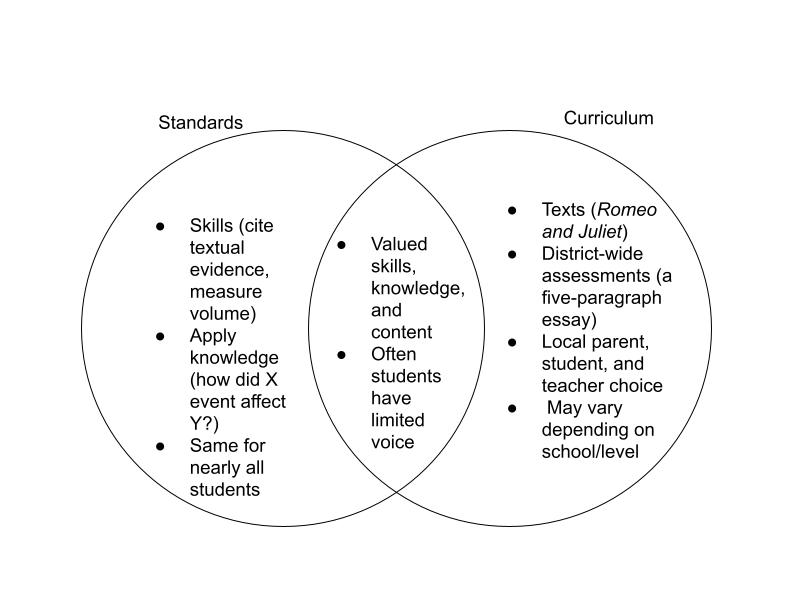
Pause & Ponder
At the center of the diagram, you will see that students often have limited voice in the creation of standards and curriculum. Did you have a say in what you learned in school? Can you think of ways that teachers could make a space for more student voice when it comes to what students learn and how they learn it?
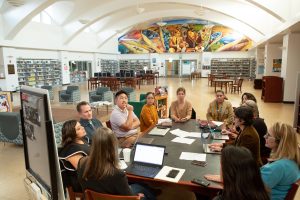
Sometimes your school or district will provide lesson plans for you, but more often, you will have the autonomy to make your own lesson plans. Teachers may be part of a Professional Learning Community (PLC) with other teachers in the same grade or content area. During these PLCs, teachers plan together and often look at student assessment data to determine what to further emphasize for students or teach in a different way. They may also have a common book or article to read in the field of education to expand their knowledge of teaching and learning. A teacher of a “special” area or elective subject like music or art might occasionally meet with teachers in other local schools to share information and discuss curriculum, lessons, or assessments. Working with others in planning is a critical skill to learn as a teacher.
One of the most effective planning strategies is Backward Design (Wiggins & McTighe, 2005). Figure 6.2 depicts a backward design planning process. While it is common for new or inexperienced teachers to focus on “filling the time,” or “what” they will teach, backward design involves following these steps:
- Identifying the desired goals and objectives;
- Determining acceptable evidence and assessments; and
- Planning instruction (Wiggins & McTighe, 2005).
This does not mean that a teacher will have the exact final assessment ready before the first day of instruction; however, teachers should have a clear idea of the format of the assessment and know what kinds of questions and content will be on it.
Figure 6.2: Backward Design Process
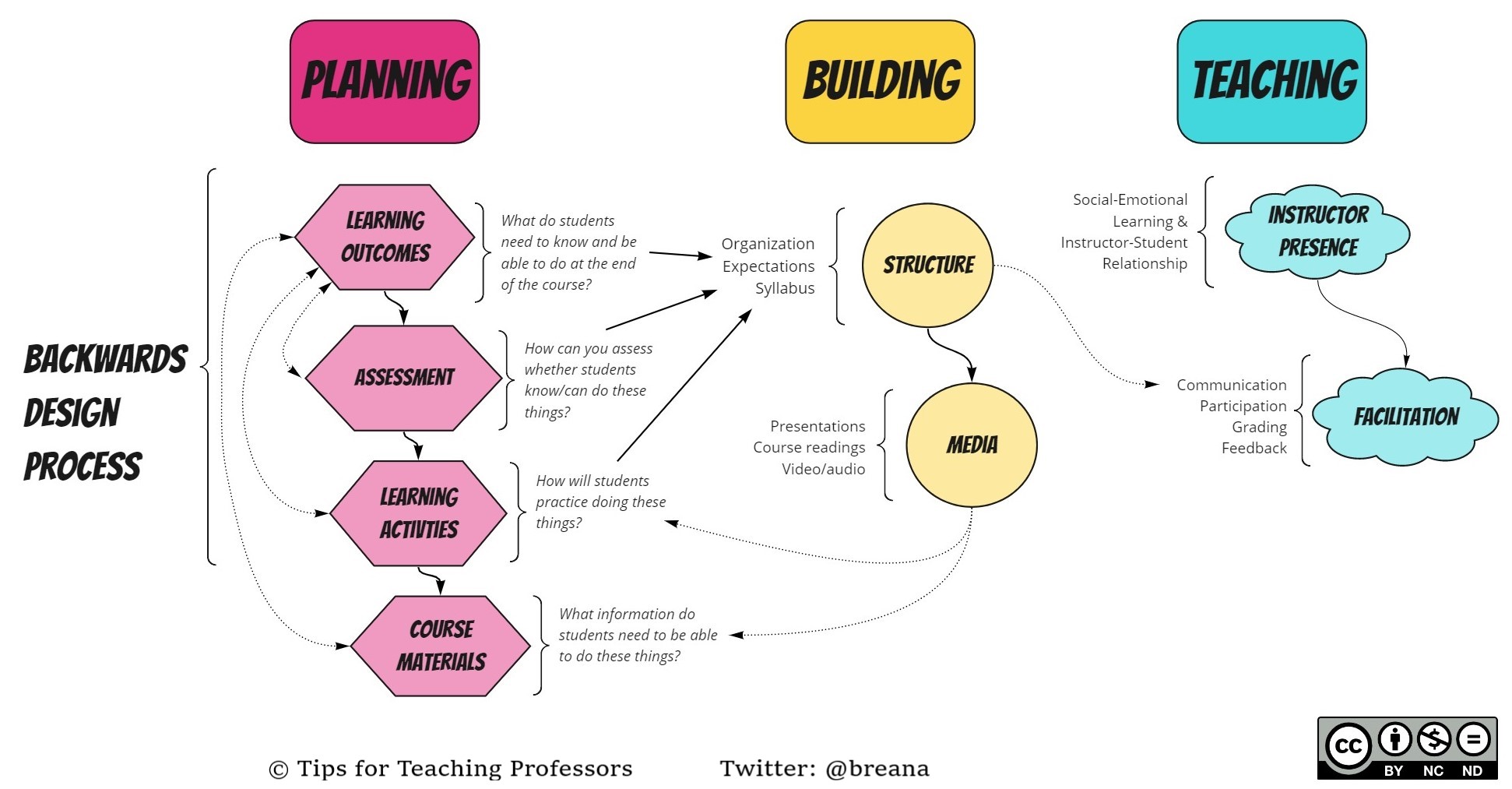
Lesson Plan Components and Models
Lesson planning is a key component to any effective instruction. Experienced teachers do not usually script their lesson plans; however, many districts will ask even seasoned teachers to turn in lesson plans for the week or month. All lesson plans will contain similar elements, sometimes in a different order.
- Standards: Select the specific standards you will teach in this particular lesson. Note that you will often choose one sub-standard, or piece, of a standard to teach, and it may take multiple lessons for students to master the content.
- Objectives: State what students will know, understand, and do by the end of the lesson. Objectives can be phrased as “The student will…” or, from a student perspective, “I can…”. Content objectives should directly relate to the standards, and language objectives should be included for English Learners.
- Materials: List all materials, such as books, resources, tools, websites, and other items that will be used for the lesson. This assists you with gathering materials so you are prepared to teach the lesson.
- Procedures: Break down the lesson into specific steps you will follow. Think of it as programming: you must provide simple, clear steps to achieve the lesson’s instructional goals.
- Differentiation: Consider how you will adapt your lesson to meet the needs of specific types of learners. For example, how will you support your English Learners, challenge your students who are gifted, or enable a student who struggles with spelling to participate without getting frustrated? Sometimes you may design a lesson around a Universal Design for Learning (UDL) framework, which means you’ve built these considerations into the plan and do not need to retrofit differentiation strategies later.
- Assessment: Explain how you will measure students’ progress toward lesson objectives and mastery of selected standards. Make sure you are collecting tangible evidence. More information on assessment will be provided later in this chapter.
In addition to these basic components, various lesson planning models exist. One common lesson planning structure is the 5 E model. The 5 E’s are engage, explore, explain, elaborate, and evaluate. This type of lesson plan is considered an inquiry-based model, in which students are encouraged to question and explore instead of receiving information directly from the teacher. (To learn more, read how one math teacher uses the 5 E components[4].) Another common approach to lesson planning is the Herbartian five-step lesson plan. It is based on more direct instruction, which involves the teacher directly giving information to students. You may hear this common type of lesson plan called the “I do, We do, You do” plan, based on the gradual release of responsibility model. This model of lesson planning includes five distinct steps:
- Anticipatory Set: Get students interested in what is to come in a lesson as a way to engage students. This can take many forms, including connections to prior learning or a model of a learning outcome or assessment task.
- Introduction of New Material: Teach new content to students, generally through direct instruction of content and checking for understanding. This is known as the “I do” phase.
- Guided Practice: Model application of new content with students as a whole class or in small groups while the teacher guides and facilitates. This is known as the “we do” phase.
- Independent Practice: Ask students to apply new content independently. This is known as the “you do” phase and can be accomplished through independent classwork or homework.
- Closure: Review the content and wrap up the lesson. Sometimes this step is referred to as a reflection, where students briefly summarize what they have learned either together or independently.
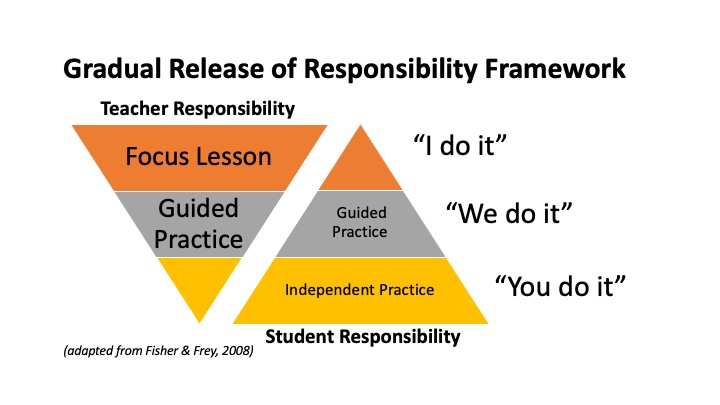 You will notice that the teacher gradually releases the responsibility for performing the target skills of this lesson to the students. While you do not have to follow these steps in order every time, a delicate balance is key. Students may feel panicked or unsupported if you ask them to do a task before showing them how it works first. At the same time, if you never release that responsibility to your students, they will never get to demonstrate their understanding. It is important for students to get ample time practicing a skill in order to master it.
You will notice that the teacher gradually releases the responsibility for performing the target skills of this lesson to the students. While you do not have to follow these steps in order every time, a delicate balance is key. Students may feel panicked or unsupported if you ask them to do a task before showing them how it works first. At the same time, if you never release that responsibility to your students, they will never get to demonstrate their understanding. It is important for students to get ample time practicing a skill in order to master it.
Critical Lens: Homework
We all have had homework during our K-12 schooling. You may have had it as early as kindergarten. There is debate about whether or not schools should even give homework, especially for a grade. Why? It comes down to issues of equity. If a family member is not available to help or is not fluent in the language of instruction, then the student has less of a chance to accurately complete a homework assignment. Since homework is often factored into grades, this can negatively impact students without additional resources. What is also important to remember as teachers is that homework should never be new material: it should always be a review and reinforcement of instruction that has already been provided. Listen to the “Is It Time to Ban Homework?“[5] podcast from Trending in Education to learn more.
Assessment
Even though you may think of instruction–the day-to-day activities of teaching–as the biggest part of your job as a future educator, assessment should actually come first. If you are following the backward design process, you should think first about your objectives and assessments, and then about the activities that the students will do.
Pause & Ponder
Think back to your own schooling. What kinds of assessments do you recall? Did you do mostly tests or quizzes? Did you do projects or speeches? What positive and negative memories do you have associated with various forms of assessment?
It is likely that when you think of assessment, you think of the grade you received at the end of an instructional unit. However, there are many kinds of assessment that serve different purposes. Table 6.1 outlines the differences among three key types of assessments: diagnostic, formative, and summative.
Table 6.1: Types of Assessments
| Type | Timing/Scoring | Purpose | Formats |
| Diagnostic |
|
|
|
| Formative |
|
|
|
| Summative |
|
|
|
Assessment can also be formal or informal. Formal assessments measure systematically what students have learned, often at the end of a course or school year. Standardized tests are a common example of formal assessments. In Virginia, students take SOL assessments (related to, but not to be confused with the SOL standards) after completing certain grade levels and content areas. These high-stakes, formal assessments are designed to measure how well students have mastered the content listed in the standards. Formal assessments may be norm or criterion referenced. Norm-referenced assessments compare students’ performance to other students. Criterion-referenced assessments compare students’ performance to specific performance criteria. On the other hand, informal assessments tend to be local, non-standardized, and contextualized in daily classroom learning activities. Informal assessments are usually performance-based, meaning students are performing, or demonstrating, their understanding through a specific task. Teachers design assessments and may evaluate them with grades, rubrics, checklists, or other scoring conventions.
You will learn more about how to design high-quality assessments as you continue your journey toward becoming a teacher. For now, remember that high-quality assessments should always relate to the standards you taught in that particular lesson. This is called alignment. In addition, good assessments ask the right questions. For example, consider which of the following is more important as a life-long literacy skill: matching a secondary character in a text to a short phrase about what that person did, or presenting a coherent argument that advances your position on a controversial topic? A useful tool for thinking about levels of questioning is Bloom’s Taxonomy (Figure 6.3). Bloom’s Taxonomy is a framework (Bloom et al., 1956) that divides levels of thinking into six categories, ranging from Knowledge to Evaluation. In response to some criticism, the taxonomy was later revised by a group of scholars, including Krathwohl (2002). The new version of the taxonomy included levels ranging from Remember to Create. It is important to understand that the framework is not meant to serve as a ladder that students must climb, where simpler knowledge and questions must always come first; rather, it is possible for students at all levels to consider information at all levels and move among them. This framework enables teachers to think about the kinds of questions they ask, and vary them as needed. Less experienced teachers tend to rely more upon lower-level questions that require basic recall skills, so be intentional about asking questions that challenge students to venture into other levels of the taxonomy as well.
Figure 6.3: Bloom’s Taxonomy (Revised)
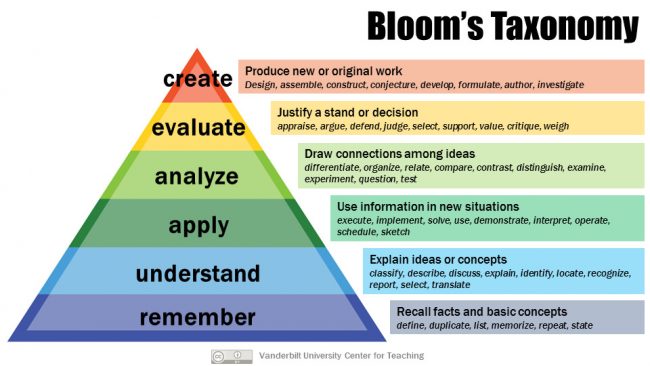
Designing and administering assessments that align with your standards and engage students at various levels of Bloom’s Taxonomy is an important first step, but another key part of effective assessments is analyzing the data you collect. Analysis of data can occur on individual student, small group, or whole class levels. If many students demonstrate a similar misunderstanding on an assessment, that data indicates the teacher should re-teach that content to increase students’ mastery. Data-driven instruction looks at the results of various assessments when considering next instructional steps. This analysis can be done by individual teachers or with colleagues in a PLC.
Assessment and grades are not the same. Grades can be a form of assessment, but not all assessments are graded. Assessments can include both quantitative and qualitative data. For example, observing students during an activity would not be a grade, but it would give you important information about what a student does or does not understand. There are many practices that exist to support students during assessments, such as IEP accommodations, differentiated assessments, retakes, and no-zero policies. Grading involves assigning scores or labels–such as letter grades, rubric scores, complete or incomplete labels, or numeric values–to a student’s performance on a task. Two forms of grading that you may have experienced in school include mastery grading and standards-based grading. Mastery grading means to structure courses in a way that allows students the time and flexibility to focus on mastering a standard rather than achieving a certain number or letter grade. Standards-based grading breaks down the subject matter into smaller “learning targets.” Each target (often phrased as an “I can” statement) is a teachable concept that students should master by the end of the course. Throughout the term, student learning on each target is recorded (Common Goal Systems, 2021). For example, in a simple grade on a report card, it may say the student received an A, or a percentage, such as 96%. In a standards-based report card, each target is broken down, such as “I can solve number sentences that have brackets”, with a score of 1-4; then, “I can find the sum of two-digit numbers”, with a score of 1-4. In this scale, 1 indicates little or no mastery and 4 indicates advanced mastery. Teachers track student progress, give appropriate feedback, and adapt instruction to meet student needs. The video below offers more explanation of standards-based grading.
The issue of grading is complex and often confusing for new teachers. There may be department-, school-, or district-wide rules about how many grades a teacher should have in a quarter or semester. Some parents and students are very focused on high grades, even if they don’t reflect the student’s actual level of understanding. There could also be policies about homework: is it graded or ungraded? Do students receive zeros for work that is not turned in, or is the lowest grade possible a 60? Most would argue that the primary purpose of the grading system is to clearly, accurately, consistently, and fairly communicate learning progress and achievement to students, families, postsecondary institutions, and prospective employers (Great Schools Partnerships, 2021); however, grading can sometimes interfere with assessments of students’ actual understanding.
Critical Lens: Reducing Bias in Grading
In an ideal world, grades and assessments are fair and impartial. However, the reality is that bias often creeps into assessment systems. One simple work-around is to use rubrics with specific criteria. Quinn (2021) conducted an experiment in which he gave teachers two second grade writing samples, one presented as a Black student’s work and one as a White student’s. Teachers gave the White student higher scores except when they used a grading rubric with specific criteria, which caused the pre-existing racial bias in the scores to disappear. Therefore, rubrics not only help students know up front what expectations are for an assignment, but also reduce opportunities for bias to impact grading.
Accountability
Accountability is a term often heard in education. It refers to holding teachers, schools, and districts responsible, or accountable, for increasing student learning and performance. Accountability carries both benefits and challenges. Of course, all educators and educational stakeholders share a common goal of advancing student learning. However, accountability can be hard to measure, and sometimes standardized test scores become the primary way to measure how effective a teacher is. This measurement can be unfair, especially when we consider the varying resources allocated to schools, the cultural bias of standardized testing, and the reality that some students are not good test takers.
Another aspect of accountability involves designing effective assessments within the classroom to measure growth in student performance. When analyzing assessments, effective teachers should consider:
- Are they fair? (Do they measure what you have taught to students? Have you asked the questions in appropriate and unconfusing ways?)
- Are they reliable? (Are the results consistent for each student and across groups of students? Would another teacher score or grade the assessment in similar ways?)
- Are they valid? (Does it measure what is designed to measure?)

Reliability and validity can be easily confused. To illustrate these concepts, let’s consider the example of a scale. If you stand on a scale, get off the scale, and get right back on the scale, you would expect to see the same number displayed. That’s reliability. Just like a reliable scale, an assessment should produce consistent (reliable) results. As for validity, you would step on a scale if you wished to measure your weight. If you got on a scale and it computed your height or your shoe size, that scale would not be measuring what it was designed to measure. Similarly, a test should measure what it is designed to measure.
What can a teacher do to ensure that their test is fair, reliable, and valid? First, teachers should plan their assessments before they begin instruction, and design the instruction to prepare students for those assessments. Teachers should regularly meet with other teachers, parents, students, and experts to get input on their assessments and the resulting data. Finally, teachers should provide many opportunities for students to practice what they have learned and get feedback before any final, summative assessment of their knowledge and skills.
Critical Lens: Invalid Assessments
An example of an assessment that was not valid was given on a standardized state test in Massachusetts to fourth graders. The essay writing portion of the test asked students to describe what they did on a snow day. When disaggregated, test results demonstrated that students from Haiti (a large population in Boston in particular) performed poorly on this portion of the standardized test. Why? Because Haiti has consistently hot weather, Haitian students had never experienced snow days and were therefore unable to write anything for this prompt. Therefore, this portion of the test was not valid because it did not measure what it was supposed to measure for Haitian students: their writing ability.
Instruction
Now that we’ve laid the foundation for an effective lesson by discussion planning and assessment, we can turn to instruction. Instruction involves the actual act of teaching a lesson and is usually what comes to mind when you envision teaching. You likely have experienced both good and poor teaching in your life as a student. Teaching is not telling. To teach well requires careful planning and knowledge of the learners in the room. There are various tools, techniques, and strategies that help teachers organize their instruction more logically and deliver it appropriately.
Pause & Ponder
What teaching strategies do you remember your teachers using that helped you the most as a learner? The least? How will your own experiences shape your future classroom instruction?
Teaching strategies are usually a series of steps that a teacher might have the students follow to encourage interaction or deeper thinking during instruction; strategies usually take from 5 to 15 minutes to enact during a lesson. An example of a strategy is “think-pair-share,” where a student turns to a partner to discuss a question or prompt before sharing with a larger group. Other strategies include using graphic organizers or creating metaphors to help students see content in a new way. You will have entire classes about teaching strategies in different content areas, often called methods courses, as you continue in your journey toward becoming a teacher. For now, we’ll investigate one very powerful, research-based strategy that can be used in all grades and content areas: Think-Pair-Share.
Think-Pair-Share is a particularly effective strategy because it allows students to share ideas with just one other person before being asked to share with the class. Students can have an opportunity to articulate their ideas prior to whole-class discussion. Extended Think-Pair-Share is a strategy used for English Learners. Instead of just an open-ended dialogue, students are prompted to use sentence frames, such as “I think the experiment showed us__________________ because I saw ___________happen.” Or, “That character in the story is very ______________. I know this because he _____________”. In this way, the dialogue is more structured with English Learners practicing correct English syntax in the process. This video shows a math teacher using the Think-Pair-Share strategy during a lesson.
Critical Lens: UDL in Instruction
As you learned in Chapter 2, Universal Design for Learning (UDL) works to reduce barriers to learners for all students before the barriers arise instead of after they become issues. Working strategies like Think-Pair-Share into your instruction helps all kinds of learners. For example, English Learners get to rehearse their speaking and listening skills in a low-stakes environment with a partner. Learn more about extending the Think-Pair-Share strategy to support ELs in your future classroom[6].
An instructional model is a longer series of steps that might provide structure to an entire 20- to 40-minute (or longer) lesson. Just as an architect uses a blueprint to build a house, so too does a teacher use models as a framework to structure their lesson. Models can be deductive and inductive. In a deductive model, the teacher provides the rule first, and then students follow it. An inductive model will ask students to figure out the rules from a completed example. These are easy to get confused–one tip to keep them clear is that direct instruction, one of the most popular and effective models, is deductive (they both start with a “D”), and inductive models involve more inquiry (they both start with an “I”). You will choose if your lesson should be deductive or inductive based on your standards, objectives, and assessments. For example, science lessons often are natural fits for inductive models, since inquiry is intrinsic to scientific discovery. However, some material works better with a deductive model.
For example, let’s imagine that Ms. Lopez is teaching students how to create an origami model of a butterfly as part of an interdisciplinary unit on art and geometry. She has several options, but one could involve showing students an origami butterfly and asking the students to figure out how to create it. This would be an inductive model of instruction. Some students may be able to do this, but most would likely be frustrated by the process. Another option could involve sharing the steps first, and guiding students through a process where they create an origami model with her feedback. This would be a deductive model of instruction, since students could follow a series of steps with the support of the teacher to produce the final product.

Deductive and inductive models both have their place in effective classroom practice, but sometimes there are misconceptions about both models. When people hear the phrase “direct instruction,” many think it means “lecture,” but they are not the same. A brief (5-15 minute) lecture might present new information, but this model is designed to guide students through a series of steps. If a teacher wishes to convey a list of dates, people, or events, the direct instruction model is not the best choice for that content. Examples of content that would work in a direct instruction model include how to write numbers in scientific notation, how to cite in MLA format, how to solve a quadratic equation, or how to write a limerick. There are many instructional models that suit various kinds of knowledge and learner needs (Estes, Mintz, & Gunter, 2015).
Table 6.2 compares a deductive and an inductive approach to a lesson with an objective of identifying the main components of a fairytale.
Table 6.2: Deductive and Inductive Approaches to a Fairytale Lesson Plan
| Deductive Lesson Plan | Inductive Lesson Plan |
|
|
When planning instructional activities, always keep them aligned with your standards, objectives, and assessments. While it can be tempting to turn to Teachers Pay Teachers, Pinterest, or TikTok for instructional inspiration, many of these “fun” activities do not result in meaningful learning. Always keep your instructional goals at the forefront of your selection of instructional activities.
Conclusion
 Curriculum, planning, assessment, and instruction are all inextricably linked. Planning instruction is like a spider web, where all of the threads are connected in a carefully designed pattern. There are different kinds of spider webs, just as there are different ways to plan and deliver instruction and assessment.
Curriculum, planning, assessment, and instruction are all inextricably linked. Planning instruction is like a spider web, where all of the threads are connected in a carefully designed pattern. There are different kinds of spider webs, just as there are different ways to plan and deliver instruction and assessment.
This chapter outlines effective methods of instructional planning, but other methods exist in the world. You may have observed a teacher teach differently, perhaps more spontaneously, and enjoyed the experience. Keep in mind that all students are not the same. What worked for you or your family or friends is likely not the best or only way that teaching should be done. Teaching is challenging, complicated work, but with a solid understanding of curriculum, planning, assessment, and instruction, teachers are prepared to reach all students and move them to the next level of knowledge, skill, and understanding.
- http://www.doe.virginia.gov/testing/sol/standards_docs/ ↵
- http://www.corestandards.org/ ↵
- https://www.doe.virginia.gov/testing/index.shtml ↵
- https://www.therouttymathteacher.com/2018/04/how-to-create-a-5e-model-math-lesson-plan.html ↵
- https://podcasts.apple.com/nz/podcast/is-it-time-to-ban-homework-trending-in-education-episode-176/id1150805729?i=1000434491636 ↵
- https://education.wm.edu/centers/sli/events/ESL%20101/extending-think-pair-share.pdf ↵
The state, district, and schools’ formal accounting of what they teach. Also called formal curriculum.
The state, district, and schools’ formal accounting of what they teach. Also called explicit curriculum.
Hidden messages that students learn from schooling that aren’t specifically in the standards and possibly aren’t even explicitly taught. Also called informal curriculum.
Hidden messages that students learn from schooling that aren’t specifically in the standards and possibly aren’t even explicitly taught. Also called implicit curriculum.
Topics that are not taught in schools at all for a variety of reasons.
Formal documents telling teachers the key information that students should understand in specific content areas at varying grade levels.
Local model of professional development in which teachers, often in the same grade level or content area, come together to plan, analyze assessment data, read a book/article, or engage in other professional development activities.
Planning concept designed by Wiggins & McTighe (1998) that involves identifying desired results and then working backward to design assessment and instruction.
Statement of what students will know, understand, and do by the end of the lesson.
Portion of a lesson plan in which all materials, such as books, resources, tools, websites, and other items that will be used for the lesson, are listed.
Portion of a lesson plan that breaks down the lesson into specific steps the teacher will follow.
Portion of a lesson plan that considers any necessary adaptations to meet the needs of specific learners, such as English Language Learners.
Framework for instructional design to meet the needs of all learners in which teachers develop lessons around three core concepts that support accessibility: engagement, representation, and expression.
Component of a lesson in which the teacher measures a student's understanding using varying techniques.
Model of lesson planning that integrates inquiry through five phases: engage, explore, explain, elaborate, and evaluate.
Model of instruction in which students are encouraged to question and explore instead of receiving information directly from the teacher.
Approach to lesson planning that includes five distinct steps: anticipatory set; introduction of new material; guided practice; independent practice; and closure. Aligns with the gradual release of responsibility and tends to rely on direct instruction.
Model of instruction in which the teacher directly gives information to students.
Model of lesson planning using direct instruction in which the teacher gradually releases responsibility for learning and demonstrating understanding to the students. Also called "I do, We do, You do."
Type of assessment administered before instruction to learn what students know prior to instruction.
Type of assessment given during instruction that gives teachers insight into students' understanding as it is forming.
Type of graded assessment given after instruction to show what students have learned.
Measure systematically what students have learned, often at the end of a course or school year, such as with a standardized test.
Formal assessment scored by comparing students’ performance to other students.
Formal assessments scored by comparing students’ performance to specific performance criteria.
Assessments that are local, non-standardized, and contextualized in daily classroom learning activities; often performance-based.
Characteristic of well-planned instruction in which multiple elements align with each other (i.e., standards, assessment, and instruction).
Framework designed by Benjamin Bloom and colleagues in 1956, and later revised in 2001. Divides educational goals/cognitive processes into six categories of increasing complexity: remember, understand, apply, analyze, evaluate, and create.
Looking at the results of various assessments when considering next instructional steps.
Model of grading in which courses are structured to allow students the time and flexibility to focus on mastering a standard rather than achieving a certain number or letter grade (i.e., often with repeated opportunities to demonstrate mastery).
Approach to grading that breaks down the subject matter into smaller “learning targets” that are scored on a continuum of 1-4 instead of being assigned letter grades or percentages.
Holding teachers, schools, and districts responsible, or accountable, for increasing student learning and performance.
Expectation that an assessment produce consistent (reliable) results.
Expectation that an assessment should measure what it is designed to measure.
A series of steps that a teacher might have the students follow to encourage interaction or deeper thinking during instruction; usually take 5-15 minutes to enact during a lesson.
Model of instruction in which the teacher provides the rule first, and then students follow it (such as during direct instruction).
Model of instruction in which students figure out the rules from a completed example (such as in inquiry-based instruction).

